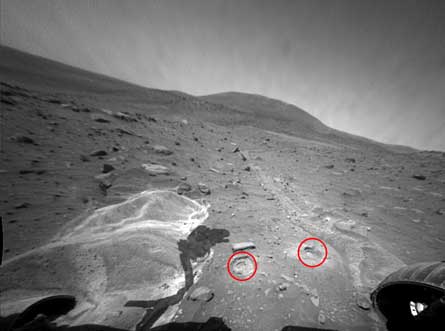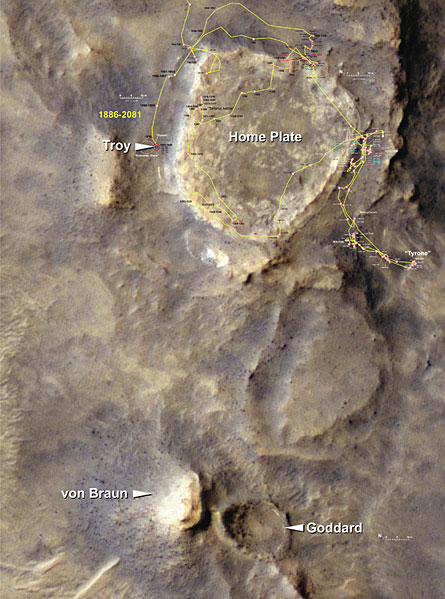Unsticking Spirit
Efforts to extract the Mars rover from a sandpit will start next week, but success is uncertain
- More than 2 years ago
The Mars rover Spirit will finally get moving after sitting wheels-deep in a sand trap for six months. But scientists aren’t sure it can escape.


“Spirit may have met its match in this one,” Mars Exploration Program director Doug McCuistion said in a press teleconference November 12 announcing plans to attempt to move the rover from its trap November 16. “This could end up being where Spirit remains.”
Spirit has been exploring the red planet since 2004, spending most of its time on a plateau called Home Plate. It got stuck in April, when its wheels punched through a thin crust in what looked like safe terrain and became mired in loose, flour-like soil beneath. The soil offered no traction and stuck to the treads. The rover is perched on the edge of a small crater with a 12 degree tilt, and a pyramid-shaped rock sits directly under the rover’s belly. If the rock is bearing any of Spirit’s weight, or if it gets caught in a cavity on the rover’s underside when the rover starts moving, it could pin Spirit to the spot.
And the rover itself isn’t healthy. Spirit has had to drive backward with only five working wheels since its front right wheel failed in 2006. Now, that wheel is still sitting on top of the crust, while the front left wheel is buried up to its axle. And another wheel stalled, or failed to rotate completely, soon after Spirit first got stuck, possibly because a small rock lodged in it. The wheel rotated freely in later tests, but it still has scientists worried.
Scientists at NASA’s Jet Propulsion Laboratory in Pasadena, Calif., have been testing strategies for freeing Spirit using a duplicate rover in a special sandbox on Earth. This approach helped Spirit’s twin, Opportunity, escape from a dune called Purgatory in 2005. Opportunity went on to study Victoria Crater for more than two years, and is now en route to Endeavour Crater.
The tests didn’t find a clear way out for Spirit. But scientists think they’ve learned all they can on Earth, and it’s time to put what they do know into practice.
“We’ve exhausted all the possibilities, all the things that we can do on the ground,” said project manager John Callas. “If there’s a way to get the rover out, we’ll find it.”
The plan for the first attempt to move Spirit on November 16 is to go full steam ahead — that is, back the way the rover came. Callas says driving back over Spirit’s tracks will offer the “path of least resistance,” and retracing its steps is safer than attempting to break new crust.
Scientists are cautiously optimistic about Spirit’s chances. Despite months of tests, “there’s no guarantee that any plan we come up with is going to succeed,” said rover driver Ashley Stroupe.
But even if Spirit’s roving days are over, it’s stuck in an interesting spot.
“No place is a nice place to be embedded, but this turns out to be a geological treasure trove,” said deputy principal investigator Ray Arvidson of Washington University in St. Louis.
Spirit’s wheels straddle what appears to be a geological boundary at the edge of an 8-meter-wide crater. The soft sand churned up by Spirit’s front left wheel has the highest sulfur content yet seen on Mars, Arvidson said. Sulfur is associated with the presence of water or steam, he said. But the material near the broken right wheel is much lower in sulfur.
“You couldn’t have told that otherwise,” Arvidson said. Finding out “required driving into the side of the crater.”
Being stuck means having more time to investigate the soil, possibly leading to unique discoveries. And time will certainly be required. The radioactive isotope that runs the rover’s spectrometer is so depleted that it now takes days to do measurements that originally took hours. “There’s still a lot of science to be had from the current location,” Arvidson said.